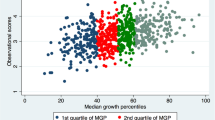Abstract
This study applies a data envelopment analysis model developed for national universities to 93 national liberal arts colleges. Such models can be used by individual institutions for benchmarking purposes or by researchers seeking to compare the practices of highly efficient liberal arts colleges with the practices of relatively inefficient colleges. Six-year graduation rate is used as the output variable. Particular attention is paid to the construction of cost per undergraduate as an input variable. In addition to a ranking of the institutions according to their efficiency, between one and five of the 18 technically efficient peer institutions were identified as peers for each of the remaining 75 technically inefficient institutions.



Similar content being viewed by others
References
Afonso, A., & Santos, M. (2008). A DEA approach to the relative efficiency of Portuguese public universities. Journal of Portuguese Management Studies, 13(1), 67–87.
Archibald, R. B., & Feldman, D. H. (2008). Graduation rates and accountability: Regressions versus production frontiers. Research in Higher Education, 49(1), 80–106.
Avkiran, N. K. (1999). An application reference for data envelopment analysis in branch banking: Helping the novice researcher. International Journal of Bank Marketing, 17(5), 206–220.
Avkiran, N. K. (2001). Investigating technical and scale efficiencies of Australian Universities through data envelopment analysis. Socio-Economic Planning Sciences, 1(35), 57–80.
Bougnol, M. L., & Dula, J. H. (2006). Validating DEA as a ranking tool: An application of DEA to assess performance in higher education. Annals of Operations Research, 145, 339–365.
Bowen, H. R., & Douglass, G. K. (1971). Efficiency in liberal education. New York: McGraw-Hill.
Breu, T. M., & Raab, R. L. (1994). Efficiency and perceived quality of the nation’s “top 25” national universities and national liberal arts colleges: An application of data envelopment analysis to higher education. Socio-Economic Planning Sciences, 28(1), 33–46.
Capaldi, E. D., Lombardi, J. V., Abbey, C. W., & Craig, D. D. (2008). The top American research universities. The center for measuring university performance. Tempe, AZ: Arizona State University.
Charnes, A., Cooper, W. W., & Rhodes, E. (1978). Measuring the efficiency of decision making units. European Journal of Operations Research, 2, 429–444.
Coelli, T. (1996). A guide to DEAP version 2.1: A data envelopment analysis (computer) program. CEPA working paper 96/08. Centre for Efficiency and Productivity Analysis. Armidale, Australia: University of New England.
Coelli, T. (1998). A multi-stage methodology for the solution of orientated DEA Models. Operations Research Letters, 23(3–5), 143–149.
Colbert, A., Levary, R. R., & Shaner, M. C. (2000). Determining the relative efficiency of MBA programs using DEA. European Journal of Operational Research, 125(3), 656–669.
Council for Aid to Education. (2008). 2006–2007 institutional report. New York, NY: Council for Aid to Education.
Duc-Le, T. (1987). Estimating the cost of a bachelor’s degree: An institutional cost analysis. Washington, DC: U.S. Department of Education.
Duffy, B. (Ed.). (September 1, 2008). America’s best colleges. U.S. News and World Report (special issue).
Ferrari, G., & Laureti, T. (2005). Evaluating technical efficiency of human capital formation in the Italian university: Evidence from Florence. Statistical Methods and Applications, 14(2), 243–270.
Koshal, R. K., & Koshal, M. (2000). Do liberal arts colleges exhibit economies of scale and scope? Education Economics, 8(3), 209–220.
Lindsay, A. W. (1982). Institutional performance in higher education: The efficiency dimension. Review of Educational Research, 52(2), 175–199.
Massy, W. F. (1990). A paradigm for research on higher education. In J. C. Smart (Ed.), Higher education handbook of theory and research (Vol. 6, pp. 1–34). New York: Agathon Press.
Naitonal Association of College and University Business Officers. (2009). NACUBO home—research—benchmarking resources—data resource details. Retrieved Feb 25, 2009, from http://www.nacubo.org/x8319.xml.
National Association of Independent Colleges and Universities. (2008). U-CAN: University and college accountability network—free. Easy. Retrieved Aug 30, 2008, from http://www.ucan-network.org.
National Center for Education Statistics. (2008). The integrated postsecondary education data system—glossary. Retrieved Aug 30, 2008, from http://www.nces.ed.gov/ipeds/glossary/?charindex=G.
National Center for Education Statistics. (2008). Detail for land improvements—end of year. Retrieved Aug 30, 2008, from http://nces.ed.gov/IPEDSPAS/showVarDetail.asp?varNumber=60636&surveyYear=06.
National Commission on Accountability in Higher Education. (2005). Accountability for better results: A national imperative for higher education. Boulder, CO: State Higher Education Executive Officers.
National Survey of Student Engagement. (2007). Experiences that matter: Enhancing student learning and success, annual report 2007. Bloomington, IN: Indiana University Bloomington.
Pascarella, E., Wolniak, G., Seifert, T., Cruce, T., & Blaich, C. (2005). Liberal arts colleges and liberal arts education: New evidence on impacts. ASHE Higher Education Report, 31(3).
Sarrico, C. S., & Dyson, R. G. (2000). Using DEA for planning in UK universities—an institutional perspective. Journal of the Operational Research Society, 51(7), 789–800.
Seifert, T. A., Goodman, K. M., Linday, N., Jorgensen, J. D., Wolniak, G. C., Pascarella, E. T., et al. (2008). The effects of liberal arts experiences on liberal arts outcomes. Research in Higher Education, 49(2), 107–125.
Shavelson, R. J., & Huang, L. (2006). Collegiate learning assessment: Conceptual framework. Retrieved Aug 30, 2008, from http://www.cae.org/content/pdf/CLA.ConceptualFramework.pdf.
U.S. Department of Education. (2006). A test of leadership: Charting the future of U.S. higher education. Retrieved Aug 30, 2008, from http://www.ed.gov/about/bdscomm/list/hiedfuture/reports/final-report.pdf.
Winston, G. C., & Yen, I. C. (1995). Costs, prices, subsidies, and aid in U.S. higher education. Discussion paper no. 32. Williamstown, MA: Williams Project on the Economics of Higher Education.
Author information
Authors and Affiliations
Corresponding author
Rights and permissions
About this article
Cite this article
Eckles, J.E. Evaluating the Efficiency of Top Liberal Arts Colleges. Res High Educ 51, 266–293 (2010). https://doi.org/10.1007/s11162-009-9157-4
Received:
Published:
Issue Date:
DOI: https://doi.org/10.1007/s11162-009-9157-4




